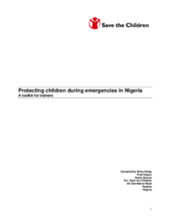Incidents of communal violence, rioting and civil conflict displace hundreds and thousands of Nigerians yearly, with children constituting over half of those affected by such emergencies. Children in populations hit by conflict may be exposed to physical violence, deprived of access to school and other basic services, and be vulnerable to spontaneous recruitment in armed gangs. Vulnerability to abuse and exploitation is increased when children become separated from their families as they flee to escape the violence.
Despite the problems faced by children in emergencies in Nigeria, evidence collected by Save the Children indicates that many of the agencies delivering humanitarian assistance are unprepared to respond to children’s specific needs. To help overcome this gap in provision, Save the Children instigated a training programme for NGO and government staff on child protection in emergencies between February and July 2005. This toolkit is a result of learning from the four training courses developed for this programme.
The toolkit is intended for those wishing to undertake training on child protection in emergencies. The toolkit provides basic information on key issues to be covered by training programmes. It suggests participatory tools for trainers on a range of issues that relate to child protection in emergencies, including child rights, exploitation and abuse, avoiding separation and caring for separated children, child participation, and contingency planning. It also suggests possible itineraries to assist in the process of selecting tools for specific groups of participants, and provides field work exercises to enable participants to apply their learning. The final section is made up of handouts that are referred to in the body of the toolkit and should be used to support the exercises.
Although this toolkit is primarily aimed at training in a Nigerian context, it is hoped that many of the tools developed will also be helpful in other settings.
©Save the Children

